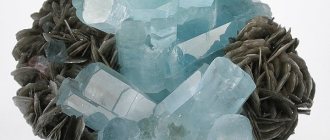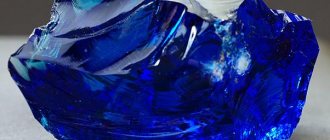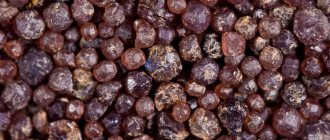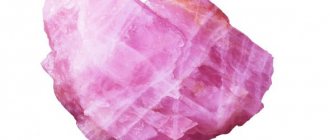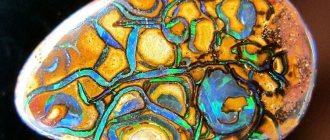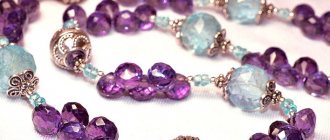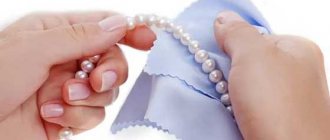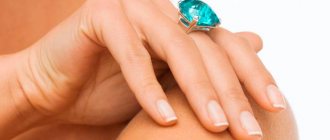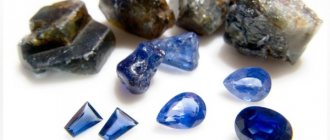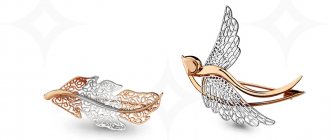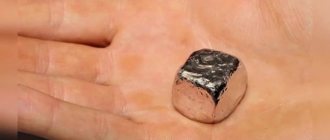Modern accessories
Accessories with opals are aesthetically attractive, unusual, and therefore in demand. Blue and milky white transparent ones are classified as precious stones, the rest are classified as semi-precious stones. But all varieties and shades are beautiful.
Range
Most often found in jewelry are blue and milky-white transparent opals. Popular expensive varieties are “matrix” (black with star-shaped tints) and “harlequin” (iridescent mosaic of triangles).
Jewelry with black Australian opal, an expensive stone with red, blue, and purple veins on a dark background, looks exotic and chic. It is processed with a cabochon dome. This is the traditional shape of stones; there are other, bizarre configurations, but the outlines are always soft and smooth. This is how the opalescence effect is best demonstrated.
More often, fragile opal is set into earrings, a pendant or a brooch. A durable Ethiopian mineral is used for a bracelet, ring or cufflinks. In other cases, the owner of opal jewelry is required to be careful when using the jewelry.
Origin
Natural opal is not considered rare, but a synthetic equivalent is almost always offered. More often they imitate black or other shades of Australian opal, white or yellow Ethiopian and blue Peruvian stone.
Yellow Ethiopian opal
| Properties | Description |
| Thermal properties | Under the blowpipe it cracks a lot, but does not melt. |
| Luminescence | Yellow-green (uranium). |
| Molecular weight | 87.11 |
| Density (measured) | 1,9-2,3 |
| Selection form | Kidney-shaped, colloform cluster-shaped, stalactite sinter aggregates, deposits, nodules, geodes, solid masses, pseudomorphs of organic remains and some minerals. |
| Chemical formula | SiO2+H2O |
| Color | Colorless, white, yellow, red, brown, blue. |
| Stroke color | White |
| Shine | Glassy, greasy, waxy, pearlescent, dull. |
| Hardness | 5,5 6 6,5 |
Compatibility
Opals of different types and colors are often used in one piece of jewelry: this combination of stones looks interesting and unusual.
Emeralds, pearls, topazes, moonstone, and chrysolites harmonize well with natural opal. Platinum or 750° gold is selected for the frame.
Synthetic opals are complemented by cubic zirconia, cultured pearls, amethysts, and are framed in silver or 585° red gold.
Who and what is jewelry suitable for?
The variety of colors plus iridescence or dullness make opal universal.
Appearance type
Opal jewelry is chosen to match the eye color:
- blue eyes - blue or blue opals;
- brown – red and green;
- gray – blue tones;
- green – purple and green stones.
Accessories with white and black opals suit everyone.
Red or fiery opal will decorate people with a winter color type (with contrast between hair and skin).
Fire Opal Ring
Gems in matte or opaque shades are suitable for other options.
Monochrome jewelry goes with any clothing in pastel or rich muted colors, multi-color iridescent opals - with monochromatic ones.
Time of year and day
Accessories with opals are appropriate all year round:
- For a sea cruise or winter wardrobe, jewelry with blue opals or rich blue ones is suitable;
- in summer they wear sparkling multi-colored silver pendants, earrings, a necklace, and a bracelet to match the dress (preferably silk);
- in autumn - sparkling yellow-brown or purplish-red opals;
- for a party or bachelorette party, a pendant or pendant made of gold with opal is suitable;
- for the office, choose small silver earrings or a ring; a business suit will make a silver brooch more feminine;
- An option for the lady boss is white Australian noble opal in platinum or gold.
Opal jewelry is equally good with casual, office or dressy clothes, shiny or embroidered with rhinestones.
Origin of the stone
Opals, formed by the evaporation of water from a hydrogel into which natural silica solutions are converted, are typical products of post-volcanic processes that occur after the outpouring of volcanic lava at one of the final stages of magma solidification.
Thanks to aqueous solutions of silica emanating from solidifying magma chambers, the mineral either settles on the Earth's surface or is deposited in cracks and voids in lavas.
Accumulations of opals are often found in places where geysers (hot springs) emerge in areas of volcanic activity.
The formation of sedimentary rocks (represented by kieselguhr, opoka, tripoli), mainly consisting of opal and occurring in the coastal zones of the seas, occurs as a result of the coagulation of silica sols transported from land by river flows.
Opals, which can replace other minerals and fill cracks in rocks, are most often products of their weathering.
The mineral is often found in sedimentary rocks: flints, flints. It is found in the cement of sandstones. Ball-shaped opals can be found in chalcedony. By impregnating the remains of plants and animals, opals form fossils.
Opals can occur in the form of very fine powder or earthy masses.
Price
Jewelry presented on the jewelry market is divided into two segments: gold and silver.
Cost of gold products (RUB):
- earrings – 32,190;
- brooch – 46 290;
- bracelet – 28,190;
- ring – 25,490.
Gold earrings with opal
Silver jewelry (RUB):
- earrings – 8 190;
- ring – 4 290;
- suspension – 990;
- brooch – 5 590.
This is an average price: the range includes products with different combinations of stones, massive opal inserts and frames.
Place of Birth
Opals are found on all continents, but the world leader in their production is Australia (the main deposit is in the mining town of Coober Pedy). Its share in world stone mining is at least 97%.
Precious opals are also mined in the following deposits:
- USA;
- Brazil;
- Mexico;
- Honduras;
- Guatemala;
- Japan;
- Czech Republic;
- Ethiopia;
- Kazakhstan.
In Russia, a small amount of ordinary opals is mined from deposits located:
- in Altai;
- in the Chita region (in the Nerchinsky district);
- in the Orenburg region (in these areas there is the Sarinsky plateau and the Kiembaevsky asbestos quarry).
- Opals are occasionally found in Ukraine (in the Kyiv and Zhitomir regions) and in Hungary.
The magic of jewelry
The main metaphysical property of the gem is considered to help in assessing specific periods of life. Opal gives an almost instantaneous understanding of events, the meaning of which under normal conditions is comprehended only years later. But this is not its only useful quality.
Therapeutic effect
Lithotherapists widely use the capabilities of opal. Jewelry with it solves the following problems:
- earrings – vulnerability of the central nervous system, reduced resistance to stress;
- necklace, brooch – heart disease, gastrointestinal tract;
- bracelet – muscular system (tics, cramps);
- pendant – infections;
- earrings – vision; you can contemplate a pebble;
- ring - potency.
Opal normalizes the functioning of the pituitary gland and pineal gland. To make the effect stronger, choose an accessory closer to the problem area.
Magic properties
The magical properties of opal are used by the official church, sorcerers and ordinary people. For residents of South America, this is a channel of communication with other worlds; in Europe, it is an attribute of the ladies of the demimonde.
The color of the opal in the jewelry matters:
- white - decorations make a person correct, virtuous, patient, forgiving; protect from moral failures;
- black is the stone of magicians and sorcerers; in others it sharpens the mind, but awakens vices; the owner of black opals will have to balance on the brink, problems await the weak-willed;
- blue is the best helper on the way to the goal; the owner becomes a clairvoyant (especially with a purple stone);
- fiery – in men it shows strength, confidence, self-sufficiency, and other masculine attributes; in women – female (also yellow Ethiopian opal).
Brooch with blue opal
The magical properties of the gem help purposeful people: if a person grabs everything at once, the opal is useless or dangerous.
Esotericists advise wearing a gold ring with an opal on the middle finger, alternately on both hands during the day. Gold increases the magical capabilities of opal.
The stone senses the moral state of the owner and loves to be with him. But taking a break from each other won't hurt.
Zodiac
Opals are suitable for all zodiac signs; the type and color of the jewelry insert matters:
- Pisces - any;
- Scorpio – black;
- Taurus - everything except black and dark;
- Aquarius – black;
- Gemini - any twinkling;
- Libra – red;
- Virgo, Capricorn – fiery;
- Cancer – red, black.
The stones are energetically incompatible with Sagittarius, Aries, and Leo. As a last resort, choose white or blue opal. They suit all signs. The main thing is that the owner of the jewelry believes in himself.
Products with synthetic opal can be worn by any zodiac sign.
| Zodiac sign | Compatibility (“+++” – fits perfectly, “+” – can be worn, “-” – strictly contraindicated) |
| Aries | — |
| Taurus | + |
| Twins | + |
| Cancer | + |
| a lion | — |
| Virgo | + |
| Scales | + |
| Scorpion | +++ |
| Sagittarius | + |
| Capricorn | + |
| Aquarius | + |
| Fish | +++ |
Magic properties
From an esoteric point of view, opal is an energetically strong mineral. It is most suitable for people living in a frantic rhythm, striving to reach heights and gain wealth. This is a stone of talent and charisma.
In the hands of a person who lives slowly and measuredly, the gem will turn into a weapon of delayed action - opal will not get along with such an owner, suppressing with its energy, bringing misfortune to the person.
For weak-willed natures, the mineral will become a source of fears and manias; the person will become suspicious and prone to conflicts. But people of creative professions form an ideal tandem with opal - the stone inspires, directs creative endeavors in the right direction, creating a protective barrier around the owner from the influence of others. The magical capabilities of the mineral directly depend on the color variety.
Black opal
This rare variety of mineral is an ideal amulet for people with a strong character and passionate nature. The owner of such a stone will be distinguished by mental acuity and the ability to think analytically.
However, it is worth remembering that such a mineral in combination with gold awakens negative qualities in a person, so black opal is not recommended for people prone to adventurism and gambling. This type of gem is used by sorcerers to perform magical rituals.
White opal
The complete opposite of black mineral. This stone is a symbol of virtue, supporting in the owner such character traits as compassion and patience. The white gem becomes a talisman for healers, philanthropists, and people working in the social sphere.
Blue opal
Minerals of blue and dark blue shades are symbols of good luck. Such an amulet is most suitable for purposeful individuals, as it helps to direct all their energy towards achieving their goals. Dark purple opal awakens the gift of clairvoyance in the owner, and also helps a person become sociable.
Fire opal
The magical abilities of this mineral are different. They depend on who the talisman belongs to - the owner or the owner. For the strong half of humanity, fire opal is a source of male confidence. And representatives of the fair sex will gain femininity, charm, and wisdom.
Pink opal
People who are not prone to fuss and adventure will find the necessary peace, harmony, and security with such a talisman. The pink mineral will create a barrier from diseases and troubles around the owner, help overcome stress, and restore restful sleep, driving away bad dreams. And this gem also acts as an assistant in love affairs.
If a person is prone to melancholy, suicidal feelings, or simply lives in a non-existent world of his fantasies, then the best gift for him would be an opal keychain or pendant set in silver.
It is believed that opal amulets of any shape, be it a figurine or an ordinary processed nugget, protect the house from the influence of natural elements, robbery, and preserve home comfort.
How to identify a fake
Almost all opal jewelry is equipped with artificial inserts, but manufacturers do not always report this.
Price is a reliable guide. Gold ring or earrings with opal for 8-10 thousand rubles. – fake.
The following signs help determine the origin of the stone:
- natural opal is unevenly colored, the surface pattern is chaotic; the fake is uniform, with an orderly pattern, garishly bright;
- in intense lighting, the opal glows from below, allowing light to pass through; if the sample is not translucent, dust particles or stains of dirt are visible inside, this is an imitation;
- synthetics have a clearly defined “scaly” appearance, created to imitate opalescence; but the reflections and tints are monochrome and sharp, in a natural gem - with a soft change in shade;
- sunlight passing through the opal creates a rainbow; synthetics are not capable of this;
- If you touch the fake with your tongue, it will stick.
Natural opals
A fake can be easily distinguished by its substrate. If it is black or dark blue and neatly glued, then it is not opal. This is how doublets or triplets are made - a combination of low-grade opal with plastic, quartz and iron ore.
Care instructions
The physical properties of opal require careful care, storage and careful use:
- jewelry is removed before going to the beach, walk, shower or pool;
- the products are washed under running water at room temperature with soap, then wrapped in a damp cloth for several hours, dried, and briefly exposed to the sun;
- opal does not tolerate household chemicals, temperature changes, boiling, or exposure to steam;
- jewelry is worn when cosmetics are applied; houses are removed, having previously been cleared of dust and sweat.
If the air is too dry, the opal will dry out and begin to crack; if the air is too humid, it will become discolored. Therefore, the best place to store jewelry with stones is a tightly closed box with constant temperature and humidity.
The dried stone is reanimated by placing it in water for several hours. Opal is fragile, so the box must be strong but soft on the inside. Avoid exposure to sunlight. Taking care of opal jewelry is not easy, but the stone is worth it.
